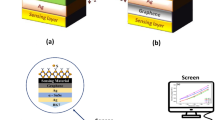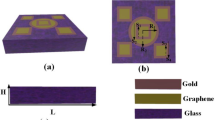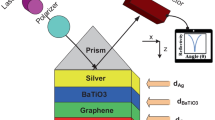Abstract
In this article, we have introduced an innovative sensor configuration employing a metasurface encompassing three rectangles configured into a star-shaped structure and multiple square-graphene elements—for accurate blood analysis. The suggested sensor architecture, characterized by its hierarchical structural configuration, offers several advantages crucial for accurate and reliable detection of target biomolecules. The star-shaped pattern, meticulously constructed with specific dimensions, significantly increases the surface area exposed to target compounds, thereby enhancing sensor sensitivity. Forensic science is at the core of investigations into crimes. It is undoubtedly crucial to modern legal structures. It is a constantly growing field that is always looking for new ways to increase the level of accuracy, sensitivity, and effectiveness of evidence examination. Terahertz (THz) spectra have recently developed as a sophisticated method with incredible potential in every aspect of forensics. A critical component of this endeavor is the development of THz sensors capable of detecting hemoglobin, a crucial protein in the evaluation of blood. The proposed sensor displays a remarkable level of sensitivity, with a maximum value of 300 GHzRIU−1 and a detection limit of 1.013 RIU−1. Moreover, the sensor demonstrates its capacity to detect subtle variations through its resolutions and Figure of Merit (FOM), quantified respectively as 0.268 and 1.796 RIU−1.







Similar content being viewed by others
Availability of Data and Materials
The data supporting the findings in this work are available from the corresponding author with a reasonable request.
References
Heavey AL, Turbett GR, Houck MM, Lewis SW (2023) Management and disclosure of quality issues in forensic science: a survey of current practice in Australia and New Zealand. Forensic Sci Int Synerg 7. https://doi.org/10.1016/j.fsisyn.2023.100339
Simon A, Barradas NP, Jeynes C, Romolo FS (2023) Addressing forensic science challenges with nuclear analytical techniques – a review. Forensic Sci Int 111767. https://doi.org/10.1016/j.forsciint.2023.111767
Butler JM (2023) Recent advances in forensic biology and forensic DNA typing: INTERPOL review 2019–2022. Forensic Sci Int Synerg 6. https://doi.org/10.1016/j.fsisyn.2022.100311
Répás J (2023) Definition of forensic methodologies for autonomous vehicles. Hadmérnök 18(1):125–141. https://doi.org/10.32567/hm.2023.1.9
Gerostamoulos D, Schumann J (2022) Blood analysis for traditional drugs of abuse. In Encyclopedia of Forensic Sciences:Third Edition 1-4:356–364. https://doi.org/10.1016/B978-0-12-823677-2.00270-1
Zhang Z, Peng D (2023) Recent advances in enhancement techniques for blood fingerprints. Crit Rev Anal Chem 53(2):442–461. https://doi.org/10.1080/10408347.2022.2111656
Larabi IA, Etting I, Alvarez JC (2023) The duration of ketamine detection in hair after treatment cessation: case study and review of the literature in forensic and clinical casework. Drug Test Anal. https://doi.org/10.1002/dta.3444
Acharjya PP, Koley S, Barman S (2022) A review on forensic science and criminal investigation through a deep learning framework. in Aiding Forensic Investigation Through Deep Learning and Machine Learning Frameworks 1–72. https://doi.org/10.4018/978-1-6684-4558-7.ch001
Bansal P, Bhargava D, Bansal P, Ali S (2022) Determination of ABO blood group and rhesus factor from teeth: a double-blinded randomized controlled trial. Online J Heal Allied Sci 21(4)
Misevic G (2018) ABO blood group system. Blood and Genomics 2(2):71–84. https://doi.org/10.46701/apjbg.2018022018113
Mohammed AK (2022) Blood groups ABO and Rh system among paternity and kinship cases of Iraqi medical legal directorate. J Educ Psychol Res 4(3). https://doi.org/10.33140/jepr.04.03.10
David Tan WC, Stasi A, Dhar BK (2022) Forensic DNA profiling in the southern border provinces of Thailand: ethical and regulatory issues. Forensic Sci Int 336. https://doi.org/10.1016/j.forsciint.2022.111322
Erlich H, Stover E, White TJ (2020) Silent witness: forensic DNA evidence in criminal investigations and humanitarian disasters. https://doi.org/10.1093/oso/9780190909444.001.0001
Silva LP et al (2022) An assessment of serological techniques for the identification of asymptomatic visceral leishmaniasis in blood donors in Northeastern Brazil. Res Soc Dev 11(6):e14011628827. https://doi.org/10.33448/rsd-v11i6.28827
Saferstein R et al (2013) Forensic science : from the crime scene to the crime lab--2nd ed. 136(1)
Kistenev YV, Borisov AV, Samarinova AA, Colón-Rodríguez S, Lednev IK (2023) A novel Raman spectroscopic method for detecting traces of blood on an interfering substrate. Sci Rep 13(1). https://doi.org/10.1038/s41598-023-31918-9
Islek D, Kiris E, Karatas O, Holumen N, Yukseloglu E (2023) Evaluation of laser-induced breakdown spectroscopy (LIBS) applications in the aspect of forensic chemistry. Nov Forensic Res 2(2):33. https://doi.org/10.5455/nofor.2023.03.05
El-Azazy M, Al-Saad K, El-Shafie AS (2022) Infrared spectroscopy - perspectives and applications. https://doi.org/10.5772/intechopen.100794
Sang J et al (2023) Effective coupling of amorphous selenium phosphide with high-conductivity graphene as resilient high-capacity anode for sodium-ion batteries. Adv Funct Mater 33(19) https://doi.org/10.1002/adfm.202211640
Almafie MR, Marlina L, Riyanto R, Jauhari J, Nawawi Z, Sriyanti I (2022) Dielectric properties and flexibility of polyacrylonitrile/graphene oxide composite nanofibers. ACS Omega 7(37):33087–33096. https://doi.org/10.1021/acsomega.2c03144
Barve K, Singh U, Yadav P, Bhatia D (2023) Carbon-based designer and programmable fluorescent quantum dots for targeted biological and biomedical applications. Mater Chem Front. https://doi.org/10.1039/d2qm01287a
Jeong S et al (2023) Highly conductive quasi-defect-free reduced graphene oxide for qualitative scalable production. Carbon N Y 203:221–229. https://doi.org/10.1016/j.carbon.2022.11.041
Li Z, Pestourie R, Lin Z, Johnson SG, Capasso F (2022) Empowering metasurfaces with inverse design: principles and applications. ACS Photonics 9(7):2178–2192. https://doi.org/10.1021/acsphotonics.1c01850
Abdelraouf OAM et al (2022) Recent advances in tunable metasurfaces: materials, design, and applications. ACS Nano 16(9):13339–13369. https://doi.org/10.1021/acsnano.2c04628
Della Valle G et al (2017) Nonlinear anisotropic dielectric metasurfaces for ultrafast nanophotonics. ACS Photonics 4(9):2129–2136. https://doi.org/10.1021/acsphotonics.7b00544
Dixon K et al (2023) Dispersion-engineered deep sub-wavelength plasmonic metasurfaces for broadband Seira applications. Adv Opt Mater. https://doi.org/10.1002/adom.202300979
Jing X, Li Y, Li J, Wang Y, Huang L (2023) Active 3D positioning and imaging modulated by single fringe projection with compact metasurface device. Nanophotonics 12(10):1923–1930. https://doi.org/10.1515/nanoph-2023-0112
Shi S, Yuan S, Zhou J, Jiang P (2023) Terahertz technology and its applications in head and neck diseases. iScience 26(7). https://doi.org/10.1016/j.isci.2023.107060
Wekalao J, Alsalman O, Natraj NA, Surve J, Parmar J, Patel SK (2023) Design of graphene metasurface sensor for efficient detection of COVID-19. Plasmonics. https://doi.org/10.1007/s11468-023-01946-2
Mezache Z, Hafdi Z, Tao J (2023) Design of a novel graphene buzzle metamaterial refractometer for sensing of cancerous cells in the terahertz regime. Optik (Stuttg) 287. https://doi.org/10.1016/j.ijleo.2023.171170
Jana A, Rane S, Choudhury PR, Chowdhury DR (2022) External bias dependent dynamic terahertz propagation through BiFeO3film. Nanotechnology 33(32). https://doi.org/10.1088/1361-6528/ac6bb2
Tu W, Zhong S, Zhang Q, Huang Y (2023) Rapid diagnosis of corrosion beneath epoxy protective coating using non-contact THz-TDS technique. Nondestruct Test Eval. https://doi.org/10.1080/10589759.2023.2214670
Ravindran N et al (2023) Recent advances in Surface Plasmon Resonance (SPR) biosensors for food analysis: a review. Crit Rev Food Sci Nutr 63(8):1055–1077. https://doi.org/10.1080/10408398.2021.1958745
Yadav A, Mishra M, Tripathy SK, Kumar A, Singh OP, Sharan P (2023) Improved surface plasmon effect in Ag-based SPR biosensor with graphene and WS2: an approach towards low cost urine-glucose detection. Plasmonics. https://doi.org/10.1007/s11468-023-01945-3
Kumar S, Yadav A, Malomed BA (2023) High performance surface plasmon resonance based sensor using black phosphorus and magnesium oxide adhesion layer. Front Mater 10. https://doi.org/10.3389/fmats.2023.1131412
D’Agata R, Bellassai N, Spoto G (2024) Exploiting the design of surface plasmon resonance interfaces for better diagnostics: a perspective review. Talanta 266. https://doi.org/10.1016/j.talanta.2023.125033
Ahmadsaidulu S, Banik O, Kumar P, Kumar S, Banoth E (2023) Microfluidic point-of-care diagnostics for multi-disease detection using optical techniques: a review. IEEE Trans Nanobioscience. https://doi.org/10.1109/TNB.2023.3291544
Comsol (2023) In: IEEE Microwave Magazine, vol 24, no 2, pp 7–7. https://doi.org/10.1109/MMM.2022.3229860
Jafari A, Broumand P, Vahab M, Khalili N (2022) An eXtended Finite Element Method implementation in COMSOL Multiphysics: solid mechanics. Finite Elem Anal Des 202. https://doi.org/10.1016/j.finel.2021.103707
Rahman MM, Mou FA, Bhuiyan MIH, Islam MR (2022) Refractometric THz sensing of blood components in a photonic crystal fiber platform. Brazilian J Phys 52(2). https://doi.org/10.1007/s13538-022-01054-2
Lazareva EN et al (2022) Refractive index measurements of tissue and blood components and OCAs in a wide spectral range. in Handbook of Tissue Optical Clearing: New Prospects in Optical Imaging 141–166. https://doi.org/10.1201/9781003025252-8
Lazareva EN et al (2022) Optical properties of glycated and non-glycated hemoglobin – Raman/fluorescence spectroscopy and refractometry. J Biomed Photonics Eng 8(2). https://doi.org/10.18287/JBPE22.08.020303
Rahad R, Rakib AKM, Haque MA, Sharar SS, Sagor RH (2023) Plasmonic refractive index sensing in the early diagnosis of diabetes, anemia, and cancer: an exploration of biological biomarkers. Results Phys 49. https://doi.org/10.1016/j.rinp.2023.106478
Sari RP, Alizar A, Isa IM, Yulkifli Y (2023) Review: Manufacturing of fiber optic based glucose sensor and infrared biosensor,” in INTERNATIONAL CONFERENCE ON APPLIED COMPUTATIONAL INTELLIGENCE AND ANALYTICS (ACIA-2022) 50026. https://doi.org/10.1063/5.0126035
Katsoulos PD et al (2017) Comparison of biuret and refractometry methods for the serum total proteins measurement in ruminants. Vet Clin Pathol 46(4):620–624. https://doi.org/10.1111/vcp.12532
Al-Dossari M, Zaky ZA, Awasthi SK, Amer HA, Aly AH (2023) Detection of glucose concentrations in urine based on coupling of Tamm–Fano resonance in photonic crystals. Opt Quantum Electron 55(6). https://doi.org/10.1007/s11082-023-04621-2
Viljoen CD, Booysen C, Tantuan SS (2022) The suitability of using spectrophotometry to determine the concentration and purity of DNA extracted from processed food matrices. J Food Compos Anal 112. https://doi.org/10.1016/j.jfca.2022.104689
Chen J, Yu B, Cong H, Shen Y (2023) Recent development and application of membrane chromatography. Anal Bioanal Chem 415(1):45–65. https://doi.org/10.1007/s00216-022-04325-8
Yanina IY et al (2023) Light distribution in fat cell layers at physiological temperatures. Sci Rep 13(1). https://doi.org/10.1038/s41598-022-25012-9
Patel SK, Surve J, Parmar J (2022) Detection of cancer with graphene metasurface-based highly efficient sensors. Diam Relat Mater 129. https://doi.org/10.1016/j.diamond.2022.109367
Fu H, Huang K, Watanabe K, Taniguchi T, Kayyalha M, Zhu J (2023) Aharonov-Bohm oscillations in bilayer graphene quantum hall edge state Fabry-Pérot interferometers. Nano Lett 23(2):718–725. https://doi.org/10.1021/acs.nanolett.2c05004
Tian C, Miao W, Zhao L, Wang J (2023) Graphene nanoribbons: current status and challenges as quasi-one-dimensional nanomaterials. Rev Phys 10. https://doi.org/10.1016/j.revip.2023.100082
Jadeja R, Surve J, Parmar T, Patel SK, Al-Zahrani FA (2023) Detection of peptides employing a THz metasurface based sensor. Diam Relat Mater 109675. https://doi.org/10.1016/j.diamond.2022.109675
Barzegar-Parizi S (2023) Refractive index sensor with dual sensing bands based on array of Jerusalem cross cavities to detect the hemoglobin concentrations. Opt Quantum Electron 55(1). https://doi.org/10.1007/s11082-022-04296-1
Cheng R, Xu L, Yu X, Zou L, Shen Y, Deng X (2020) High-sensitivity biosensor for identification of protein based on terahertz Fano resonance metasurfaces. Opt Commun 473. https://doi.org/10.1016/j.optcom.2020.125850
Saadeldin AS, Hameed MFO, Elkaramany EMA, Obayya SSA (2019) Highly sensitive terahertz metamaterial sensor. IEEE Sens J 19(18):7993–7999. https://doi.org/10.1109/JSEN.2019.2918214
Funding
The authors are thankful to the Deanship of Scientific Research at Najran University for funding this work under the Research Groups Funding program grant code (NU/RG/SERC/12/2).
Author information
Authors and Affiliations
Contributions
“Conceptualization, Abdulkarem H. M. Almawgani and Shobhit K. Patel; methodology, Abdulkarem H. M. Almawgani, Shobhit K. Patel, Jacob Wekalao; Software, Jacob Wekalao, and Abdulkare H.M. Almawgani, Arunkumar U; Validation, S. Gopinath. Arunkumar U. and Yahya Ali Abdelrahman Ali; writing—original draft preparation, Jacob Wekalao and Rinku Manvani; Formal Analysis, All Authors; writing—review and editing, All Authors; All authors have read and agreed to the published version of the manuscript.”
Corresponding author
Ethics declarations
Ethical Approval
Not applicable.
Competing Interests
The authors declare no competing interests.
Additional information
Publisher's Note
Springer Nature remains neutral with regard to jurisdictional claims in published maps and institutional affiliations.
Rights and permissions
Springer Nature or its licensor (e.g. a society or other partner) holds exclusive rights to this article under a publishing agreement with the author(s) or other rightsholder(s); author self-archiving of the accepted manuscript version of this article is solely governed by the terms of such publishing agreement and applicable law.
About this article
Cite this article
Wekalao, J., U, A.K., S, G. et al. Graphene-Based THz Surface Plasmon Resonance Biosensor for Hemoglobin Detection Applicable in Forensic Science. Plasmonics (2023). https://doi.org/10.1007/s11468-023-02146-8
Received:
Accepted:
Published:
DOI: https://doi.org/10.1007/s11468-023-02146-8




